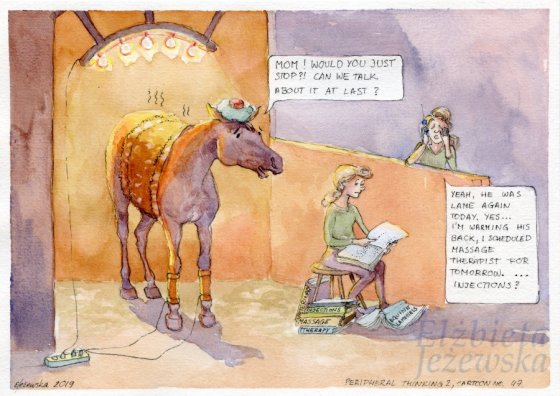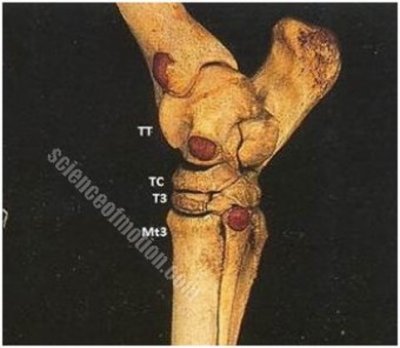Peripheral Thinking
Peripheral Thinking
Jean Luc Cornille

As long as one believes that a bamboo pole will make the horse piaff, one is in the world of peripheral thinking. One is asking a dysfunctional horse to perform a move for which the horse’s physique is not adequately developed and coordinated and lameness is around the corner. The whole system will then continue to orbit around the problem bouncing from one therapy to the other without ever identifying and addressing the root cause
During the piaff, the decelerating activity of the hind legs increases considerably resisting forward shift of the body over the forelegs. Activating the hind legs with whatever artificial means stimulated the propulsive activity of the hind limbs lifting the croup and shifting the weight over the forelegs. At the contrary of the hind legs, the forelegs develop during the piaff a strong upward propulsive activity, which can only be done if the weight on the forelegs is reduced to the minimum. The elevation of the forelegs is for a great part the recoil of an elastic energy stored in the tendons, fascia, aponeurosis and muscles during the stance. Increasing the propulsive activity of the hind legs loads the forelegs hampering efficient, elegant and sound elevation of the front legs. The peripheral industry stimulates then the activity of the front limbs snapping the limbs with a device. Such peripheral thinking alters the cycle of storage and reuse of elastic energy degrading the performance into a pantomime and condemning the horse to lameness.
Once pathological damages have occurred, the same peripheral thinking is going to focus on the joint, tendon, ligament, muscle or fascia showing stress but will not concentrate on the root cause; the dysfunction inducing abnormal stress on the joint, tendon, ligament, muscle, and fascia. During piaff, like during cursorial locomotion, the muscular system of the thoracolumbar spine converts the thrust generated by the hind legs into horizontal, upward and other forces necessary for the gait or performance. Any dysfunction between one side and the other of the epaxial spinal muscles will alter the capacity of the back muscles to properly manage forward through the thoracolumbar spine, the thrust generated by the hind legs, loading abnormally one limb or the other, or a specific joint. Stall rest might be necessary for the healing of a specific lesion, but restarting the horse with a progressive number of minutes without addressing and correcting the thoracolumbar dysfunction loading abnormally the damaged joint is peripheral thinking.
The reason for the existence and persistence of peripheral thinking is that the source of all body movements, the equine vertebral column, is not regarded as the source of all body movements. This is why the medical world does not offer better therapy than corrective shoeing. The balancing of the hoof is an important part of the equation as it manages the way the forces are absorbed and managed by the hoof. The other important part of the equation is the direction, duration, intensity and frequency of the forces acting from the back down onto the limb. This aspect is the task of the thoracolumbar spine’s proper function. The muscular system of the equine thoracolumbar spine is powerful and complex. The muscles manage a very large diversity of forces and movements within a reduced range of motion. Peripheral thinking believes that this muscular system functions at the level of stretching and relaxation. By contrast, actual knowledge explains the opposite There is a very large elastic-stiffness diversity across vertebrate muscle. The functional anatomy is in line with the function. Muscles resist, reduce, redirect, convert forces and instead of gestures such as the shifts of the rider weight, that stimulate protective reflex contractions, the equitation needs to be based on a neutral balance, a rider balance inducing no forward or backward shifts of the rider’s weight, and refine the relation with the horse at the level of subtle nuances in muscle tone.
Peripheral thinking injects the hocks.  Upgraded thinking learns about the inward rotation, medial to lateral and lateral to medial that occurs in synchronization with the flexion/extension of the joint. Upgraded thinking applies then the knowledge focusing on the source. Since the inward rotation of the lower joints, Mt3 T3 is created by the down and up translation of the fetlock and its own rotation, since the inward rotation of the higher joints TC and TT is synchronized with the flexion/extension and inward rotation of the stifle, it is quite obvious that both the balancing of the hoof and the proper function of the thoracolumbar spine are involved. Peripheral thinking walks a progressive number of minutes after serious damage recreating each stride the same stress on the same joint. Upgraded thinking, prevents hocks damages ensuring proper kinematics of the thoracolumbar spine and hind limbs. If it is too late and damages have occurred on the hock joint, upgraded thinking address and corrects the root cause avoiding each stride the same stress on the same joint. Of course, this cannot be done applying the equitation that caused the damages at the first place. Of course, this cannot be done integrating the finding of new researches studies to the equitation that caused the problem at the first place. This can be done, upgrading the equitation as well as the work in hand to actual knowledge. Jean Luc Cornille
Upgraded thinking learns about the inward rotation, medial to lateral and lateral to medial that occurs in synchronization with the flexion/extension of the joint. Upgraded thinking applies then the knowledge focusing on the source. Since the inward rotation of the lower joints, Mt3 T3 is created by the down and up translation of the fetlock and its own rotation, since the inward rotation of the higher joints TC and TT is synchronized with the flexion/extension and inward rotation of the stifle, it is quite obvious that both the balancing of the hoof and the proper function of the thoracolumbar spine are involved. Peripheral thinking walks a progressive number of minutes after serious damage recreating each stride the same stress on the same joint. Upgraded thinking, prevents hocks damages ensuring proper kinematics of the thoracolumbar spine and hind limbs. If it is too late and damages have occurred on the hock joint, upgraded thinking address and corrects the root cause avoiding each stride the same stress on the same joint. Of course, this cannot be done applying the equitation that caused the damages at the first place. Of course, this cannot be done integrating the finding of new researches studies to the equitation that caused the problem at the first place. This can be done, upgrading the equitation as well as the work in hand to actual knowledge. Jean Luc Cornille


 twitter
twitter facebook
facebook google
google pinterest
pinterest yahoo
yahoo linkedin
linkedin